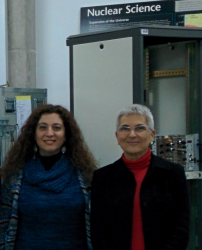Observation of the β-Delayed γ-Proton Decay of 56Zn by the Gamma Spectroscopy Group of IFIC, published in PRL
An experimental collaboration leaded by the researchers of IFIC Sonja Orrigo and Berta Rubio has observed a very exotic decay mode at the proton drip line in the β decay of the Tz= −2 nucleus 56Zn, the β-delayed γ-proton decay. This decay had only been observed recently in the much lighter nuclide 32Ar, and now its observation has been reported in the itermediate-mass 56Zn. The experimental results and their impact on the evaluation of the Gamow-Teller transition strength have been published in Physical Review Letters:
http://journals.aps.org/prl/abstract/10.1103/PhysRevLett.112.222501
In general, when the strong interaction process (proton decay) is possible, it is dominant over the electromagnetic process (γ decay). Usually, in proton-rich nuclei the proton decay dominates for states well above the proton separation energy; thus the β-delayed proton emission followed by γ decay is a process which is commonly observed. In the decay of 56Zn, a competition between β-delayed proton emission and β-delayed γ de-excitation is seen from two states of 56Cu populated well above the proton separation energy. Moreover, β-delayed γ rays are observed that populate levels in the daughter nucleus that are proton-unbound and decay by proton emission. The β-delayed γ decay followed by proton emission is a very rare process, but it is also very important because it will strongly affect the conventional determination of the Gamow-Teller strength at the proton drip line, especially in heavier systems in which it may become a common decay mode.
This experiment was carried out at GANIL (France) by an international collaboration including researchers of the IFIC Gamma Spectroscopy Group, RCNP Osaka, Bordeaux Gradignan, Surrey University and Instanbul University, among others.




















